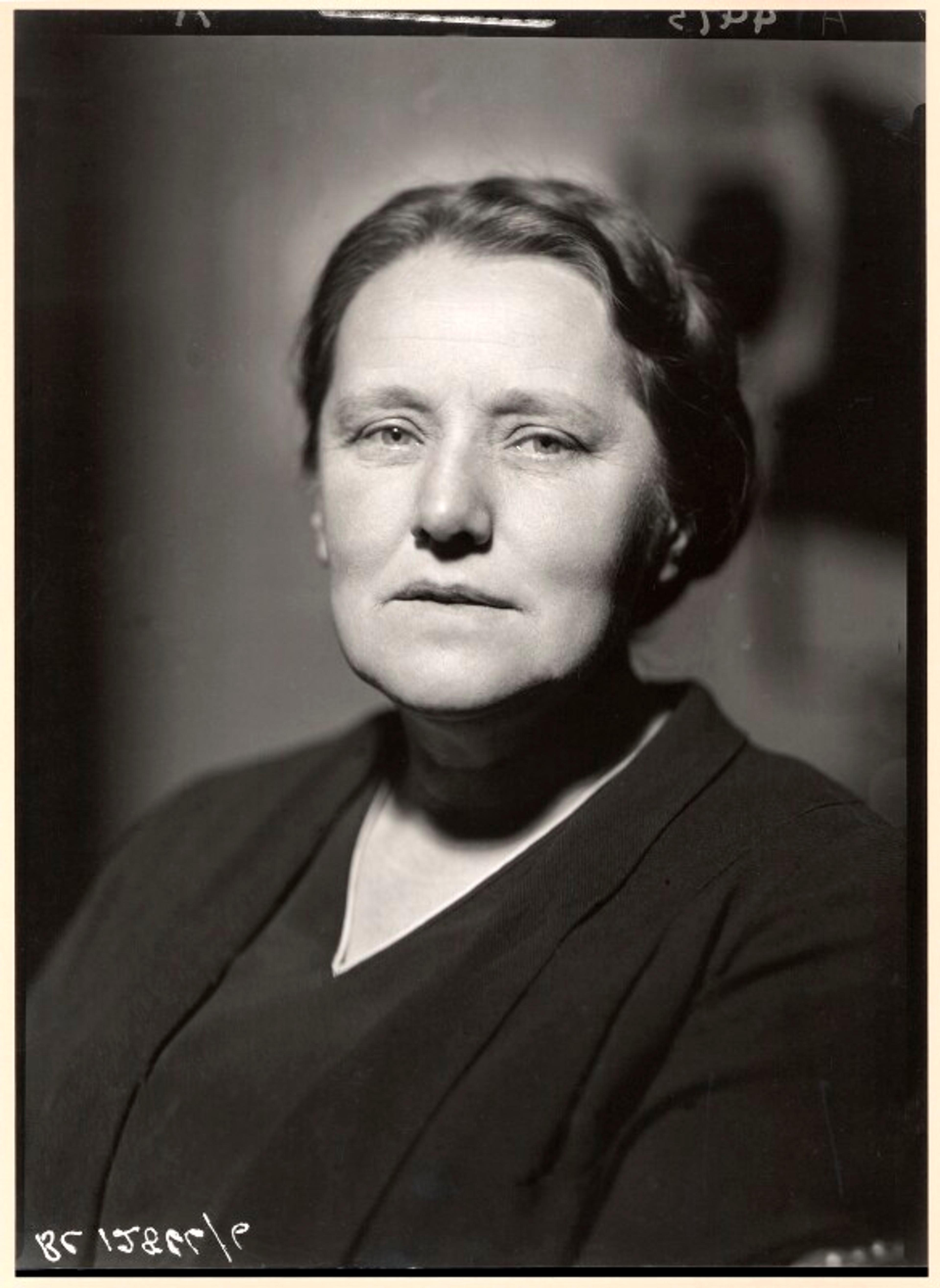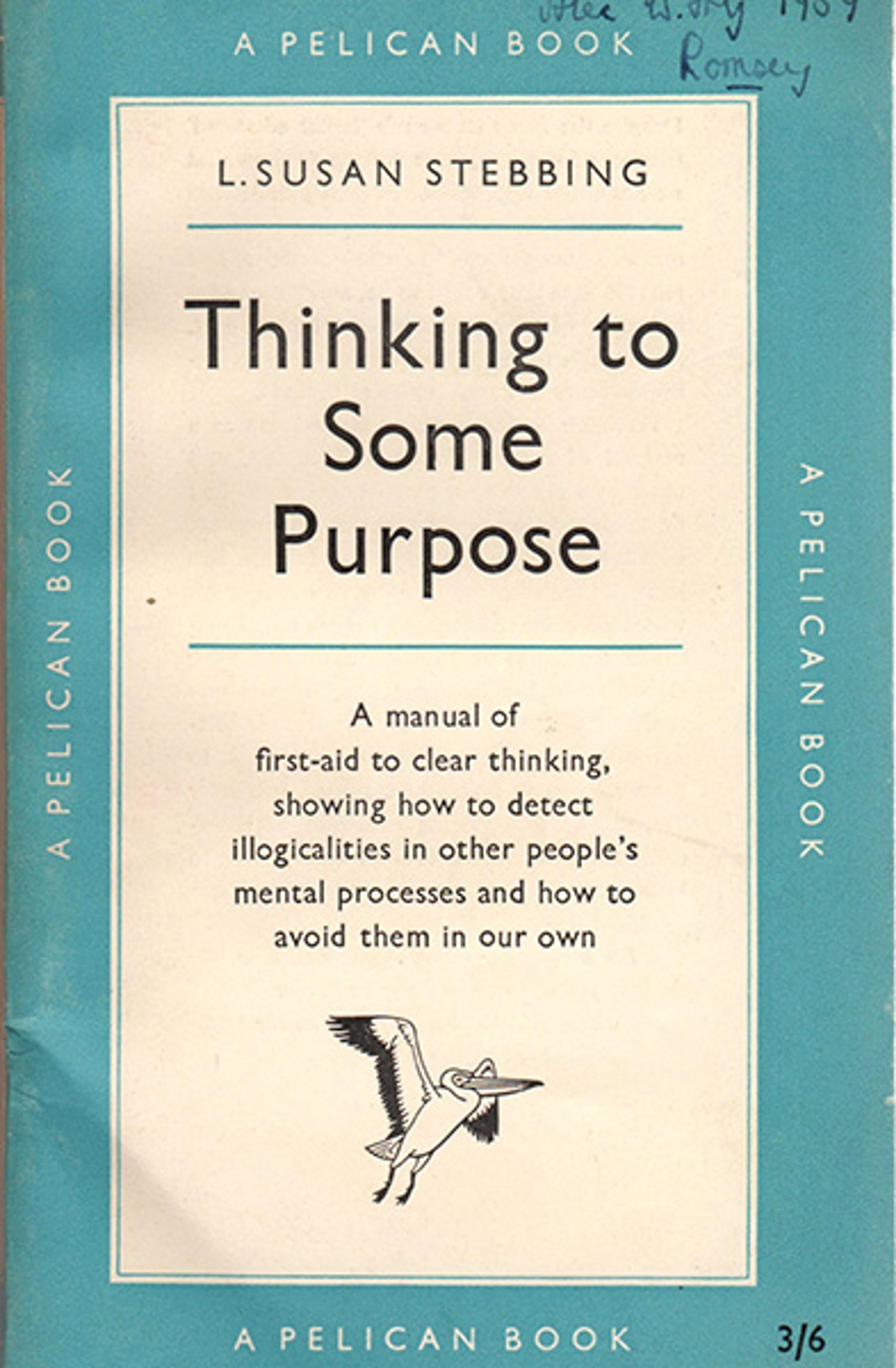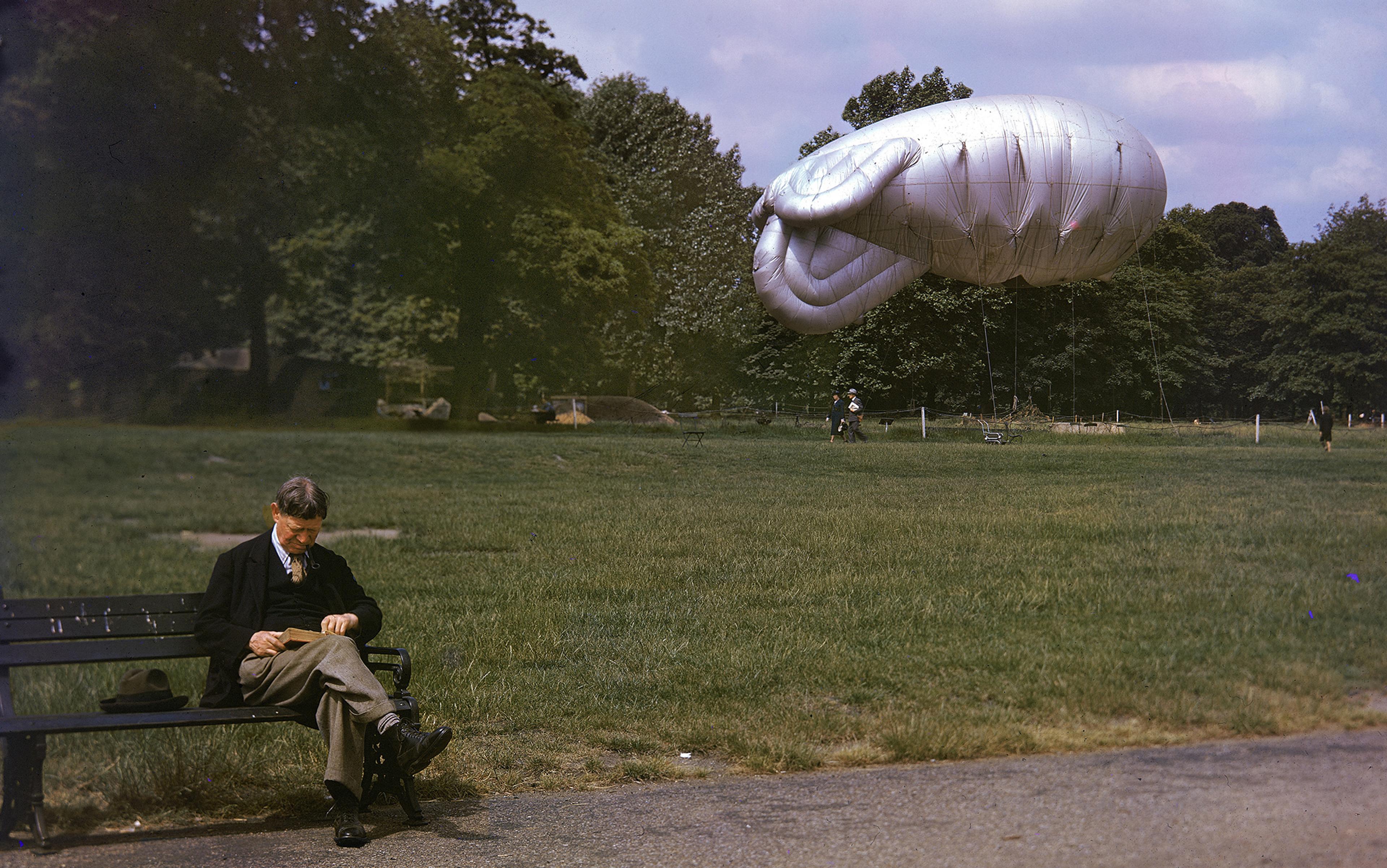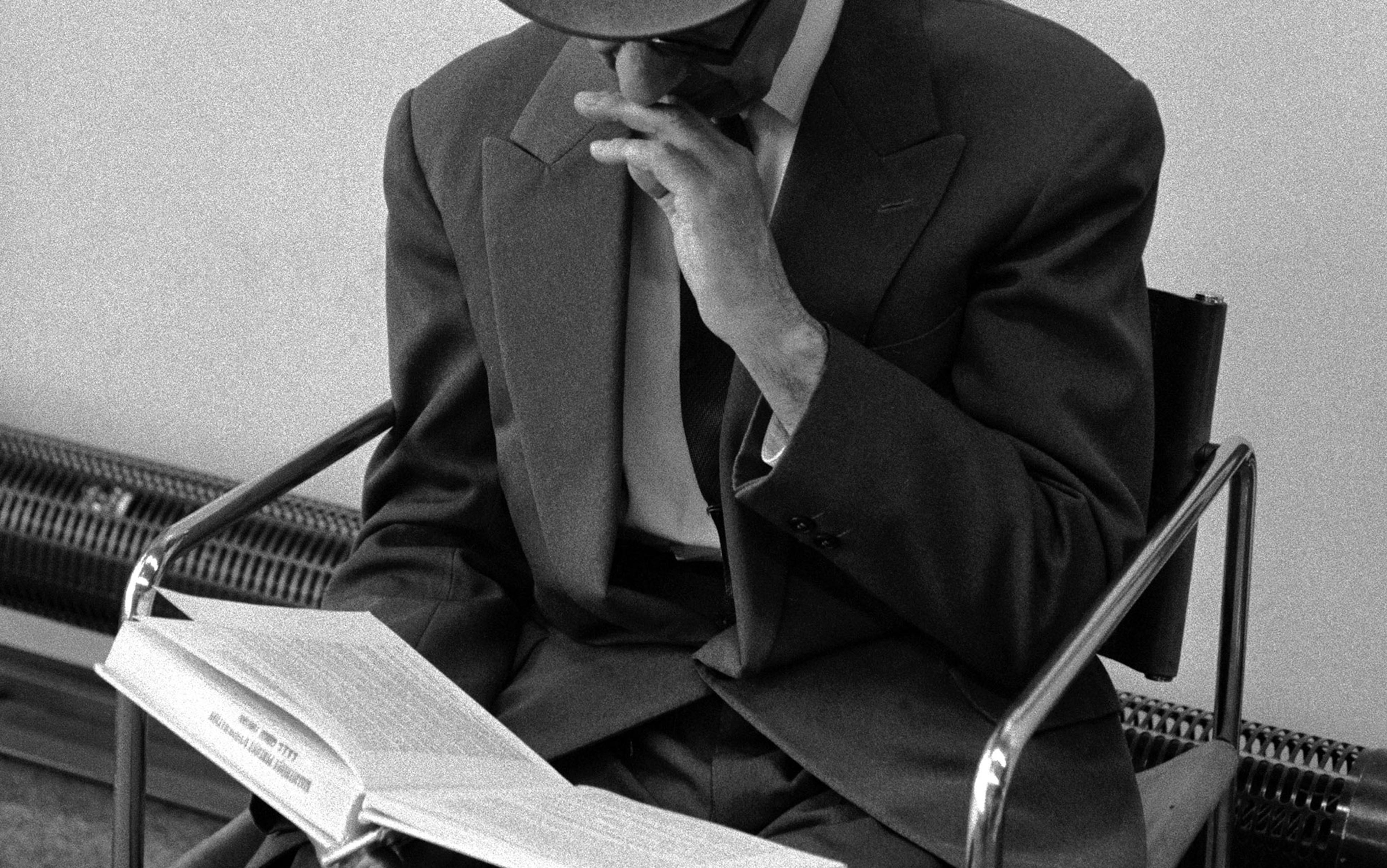‘There is an urgent need today for the citizens of a democracy to think well.’ These words, which could have been written yesterday, come from Thinking to Some Purpose, a popular book by the British philosopher Susan Stebbing, first published in 1939 in the Penguin ‘Pelican’ books series, with that familiar blue-and-white cover. This little book, which could easily be slipped into a pocket and read on the train, in a lunch hour, or at a bus stop, was pitched at the intelligent general reader. In Thinking to Some Purpose, Stebbing took on the task of showing the relevance of logic to ordinary life, and she did so with a sense of urgency, well aware of the gathering storm clouds over Europe.
Stebbing was a university lecturer and then professor in a philosophical world almost completely dominated by men. She began by publishing as L S Stebbing (‘Lizzie’ was her given first name, but she despised it, and was always known as ‘Susan’) because, one friend suggested, she disliked philosophical debates getting distorted by questions of gender or status. In 1933, Stebbing was the first woman in the United Kingdom to be appointed to a full professorship in philosophy – at Bedford College, where she spent much of her career. While this made national news at the time, Stebbing is now scarcely known outside specialist academic circles, and has accrued nothing like the almost-mythic aura that surrounds philosophical ‘greats’ such as Bertrand Russell or G E Moore (both of whom were her contemporaries). She is also less well known than other women philosophers who came to the fore in the postwar period, such as Elizabeth Anscombe, Philippa Foot, Iris Murdoch and Mary Midgley.

Lizzie Susan Stebbing photographed in 1939 by Howard Coster. Photo © National Portrait Gallery, London
Stebbing was born in north London in 1885 and educated at Girton College, Cambridge and King’s College, London between 1904 and 1912. She died in 1943 aged just 57 from cancer. In the author description of Thinking to Some Purpose, she mentions that she’d been interested in philosophical problems from childhood, ‘almost before she knew the meaning of the word philosophy’. But it was after reading F H Bradley’s Appearance and Reality (1893), which she came upon by chance, that she switched from studying history at Cambridge to what was then known as moral sciences. Bradley’s shadow would continue to loom large throughout Stebbing’s career, much of which she spent refuting idealism, which Bradley endorsed. This early childhood interest in philosophy is exemplary of the fact that, for Stebbing, philosophy was not simply about solving problems set by men in Cambridge or Oxford but a way of life – and, as such, not something that required a university education or a post at a prestigious academic institution.
This is not to downplay Stebbing’s academic credentials. Her academic publication record was impressive. Between 1924 and 1939, she published at least one article each year in some of the leading philosophy journals of the time. Her name was well known to most professional philosophers, at least in the English-speaking world. However, Stebbing was always interested in doing things and actually solving problems, not just thinking about them. For example, in the 1930s and ’40s, she spent a considerable amount of time and energy securing the safety of refugees from Germany and Nazi-occupied countries at her own personal cost.
In Thinking to Some Purpose, a philosophical text directed at the general public, she doesn’t settle for simply reflecting on various issues. Instead, she aims to educate people about how philosophy can be of benefit to the real world while also training its readers in how to practise it. The book is described on the cover of the Pelican edition as ‘A manual of first-aid to clear thinking, showing how to detect illogicalities in other people’s mental processes and how to avoid them in our own.’ Just as a car-user’s manual instructs the owner on how to (and how not to) navigate the road, Thinking to Some Purpose was written to provide its readers with manual for how to start thinking in the right kind of way and avoid common pitfalls.

By suggesting that her readers (the general public) need to learn to think clearly, and helping to provide the means, Stebbing was adding herself to a long line of philosophers known as ‘freethinkers’. ‘Freethinking’ dates back to the European Enlightenment and originally involved rejecting religious authority and academic dogma in the light of new developments in science. Essentially, freethinkers pushed for a democratisation of knowledge and believed we should follow our own reason over the Bible or ancient philosophical texts. The frontispiece to Thinking to Some Purpose even includes a quotation from the 18th-century philosopher Anthony Collins, who literally wrote the textbook on freethinking. The quotation, which is from Collins’s A Discourse of Free-thinking (1713), reads:
if we have a right to know any Truth whatsoever, we have a right to think freely … there is no other way to discover the Truth.
Like the freethinkers of the 17th and 18th century, Stebbing believed that we should eschew authority as a source of knowledge and instead rely on our own rational abilities (although she was more interested in shaking off the authority of institutions such as the privately owned press than the Church).
Stebbing believed that individuals are truly free only when they’re able to think clearly. For her, writing as the shadow of fascism fell over Europe in the 1930s, this was a pressing issue. In the Epilogue to Thinking to Some Purpose, she tells the reader that: ‘My topic is freedom of mind.’ She then continues:
If it were in fact true that we were all politically and economically free, still it would not follow that we were possessed of the freedom of mind without which, in my opinion, no democratic institutions can be satisfactorily maintained.
She thus drew a line between ‘political and economic’ freedom – the kinds of freedom that democratic nations traditionally seek to uphold – from ‘freedom of mind’. For Stebbing, freeing one’s own mind is, uniquely, one’s own personal responsibility, and is, she explains, hindered by ignorance. People might appear to be free, because they live in a liberal democracy, but this apparent freedom can be illusory. Genuine freedom consists in individuals knowing how to think freely.
Hoping to get her point across to the general reader, Stebbing uses an example from her own personal experience, describing how, when the UK’s general strike of May 1926 occurred, she’d been completely ignorant of the events that led up to it. Stebbing explains how her lack of information made it impossible to arrive at an opinion on the matter of which she could be confident, since she was unable to think deeply about it for herself. ‘My ignorance,’ she writes in Thinking to Some Purpose, ‘made me unfree.’
What does thinking clearly involve? One important step, Stebbing argues, is to train ourselves out of bad habits of thinking. For example, she describes what she calls ‘potted thinking’. This is oversimplifying ideas using crude characterisations or slogans. While slogans aren’t always a bad thing, Stebbing thinks that they have a tendency to oversimplify more nuanced or sophisticated views and to hide the intricacies of an idea behind a catchy phrase. As an example of potted thinking, she points to how some people say that Freudian psychoanalysis can be encapsulated in the slogan ‘Everything is sex.’ This falsely gives the impression that Sigmund Freud’s theory reduces everything to sex, that his approach is easy to understand, and (worst of all) makes Freud’s views sound utterly ridiculous – so ridiculous, in fact, that one begins to wonder why on earth anyone ever paid any attention to his views in the first place. But, regardless of whether one sees any value in Freud’s actual views, Stebbing explains, we should avoid expressing them in such a ‘potted’ form.
The worst type of potted thinking is when we start talking in slogans that have no thought behind them
To the contemporary reader, this metaphor is perhaps a little dated, with her talk of ‘potted thinking’, because Stebbing is drawing a comparison with potted meat: a vacuum-packed product such as Spam that you might find in a wartime ration pack. She is careful to explain that we should always stop and examine the metaphors we see being used in public discourse. (As she puts it: ‘Do not accept the metaphor too hastily’!) With that in mind, she explains the metaphor:
Potted meat is sometimes a convenient form of food; it may be tasty, it contains some nourishment. But its nutritive value is not equivalent to that of the fresh meat from which it was potted. Also, it must have originally been made from fresh meat, and must not be allowed to grow stale. Similarly, a potted belief is convenient; it can be stated briefly, sometimes also in a snappy manner likely to attract attention.
Her point is that potted thinking takes something that once had high ‘nutritive value’ and packages it in a way that’s easier to sell but harder to find any genuine nourishment in. The worst type of potted thinking, according to Stebbing, is when we grow into the habit of ‘using words repeated parrot-fashion’ – put another way, when we start talking in slogans that have no thought or consideration behind them at all.
Another bad habit that Stebbing focuses on is the ambiguous use of important words (what logicians call ‘equivocation’), which can often result in people talking past each other. Pre-empting somewhat the pragmatist philosophy of language that would be endorsed by J L Austin, Stebbing emphasises that words are tools used in particular contexts, and that the meaning of words can change depending on where and when they’re spoken or written. The most subtle hints (‘a bodily gesture, a tone of voice, a frown or a smile’) could indicate a change in context but can easily be missed. In everyday conversation, this is unlikely to cause too many problems. However, difficulties arise when words are used ambiguously in important public debates.
Stebbing gives the example of the word ‘non-intervention’ in the context of the Spanish civil war in the 1930s. She explains how, in a literal sense, ‘non-intervention’ means ‘not intervening at all’ but how, in the context of the civil war, it has picked up an association with ‘neutrality’. This has resulted in both sides of the political spectrum using the term ‘non-intervention’ in a way that’s detached from its literal meaning. In turn, this generates further ambiguity. To rectify the situation, Stebbing explains that we can do nothing but make it as clear as possible how we’re using certain terms and in what context:
All that we can do is to see that we understand clearly the words we use in our own thinking, and try to convey to our hearers what precisely it is that we are using these words to convey.
Again, Stebbing explains that thinking (and speaking) clearly is key to successful public discourse.
Stebbing completed Thinking to Some Purpose in November 1938, just under a year before the outbreak of the Second World War. Social and political developments in Germany and Russia are referred to throughout the text, and Stebbing was keen to compare and contrast them with politics at home in Britain. In particular, while she emphasised the value of the democratic system, she was also keen to point out the ways in which it would come under pressure if we didn’t endeavour to think freely both as individuals and as a nation. Stebbing believed that our very freedom itself is at stake if we don’t learn to think clearly.
However, it’s not all negative. Stebbing’s vision of the world, as she presents it in Thinking to Some Purpose, is essentially democratic. Each individual has the ability to think clearly; they just might not have had the kind of training that she had. For that reason, Stebbing offers her readers a manual – not a dogma – that individuals can use in order to secure their own freedom of thought. As evidence for the idea that each individual has the ability to think clearly, Stebbing uses the example of a child called Emily who, after being told by a nurse that ‘nobody eats soup with a fork’, replies: ‘I do, and I am somebody.’ Stebbing takes this as proof that people who are untrained in logic, even children, can still reason successfully (in this case, by identifying a false generalisation). In other words, she thinks that such an example shows that we all have the potential to do what trained logicians do; namely, not only disagree with certain claims but work out what’s wrong with the reasoning that lies behind them.
In many ways, Thinking to Some Purpose is a product of its time. The 1930s, ’40s and ’50s saw a rise in autodidacts: self-educated individuals who weren’t able to attend university, but nonetheless found themselves with a hunger for knowledge. The Pelican series (pioneered by Allen Lane) was designed to feed this hunger. As Lane himself put it, the Pelican books were ‘another form of education for people like me who’d left school at 16’. With Thinking to Some Purpose, Stebbing clearly bought into the spirit of Lane’s initiative and set out to do for philosophy what other Pelican books had done for history, literature and the sciences.
However, Thinking to Some Purpose is an important philosophical text for more than just historical reasons. Now, more than ever, philosophers are trying to find ways to promote their skills and ideas in the world outside university departments. For instance, there are several long-running and much listened-to philosophy podcasts, and books of popular philosophy are sometimes bestsellers. Already, philosophers are publishing volumes on the COVID-19 pandemic and how to cope with it. There are also ongoing discussions among philosophers, in more specialist settings, about what the aims of public philosophy should be and how it should be carried out.
A recent blog post by the philosopher Timothy Williamson was widely circulated online in which he draws a distinction between popular philosophy and populist philosophy. Williamson argues that while the democratisation of knowledge in general should be encouraged, it should nonetheless be up to professional, academic philosophers to find ways to communicate their research and ideas to a public audience. For Williamson, philosophy is not something we can all do equally well; like any other science, it’s something that one has to be trained to do, since it involves adopting highly sophisticated research methods and familiarising oneself with a considerable amount of both historical and contemporary literature. Good popular philosophy, Williamson argues, is just like good popular science. It occurs when a specialist in the field finds a way to communicate their findings to non-specialists in an engaging and informative manner. If Williamson is right, a good popular philosopher is to philosophy what Bill Nye is to science.
Public philosophy is a two-way street. It requires an audience that’s proactive and eager to acquire knowledge
This is a very different model of public philosophy to the approach that Stebbing adopts in Thinking to Some Purpose. According to her, one role of philosophy is to help us think clearly. This requires not only having the relevant information in front of us, but also knowing what to do with it. On Stebbing’s model of public philosophy, the aim is to train a public audience to develop practical thinking skills that are applicable in a range of contexts. This requires more than just a transfer of knowledge from an expert who has carried out the prerequisite research.
On this model, public philosophy is a two-way street. It doesn’t resemble a traditional university setting, where a lecturer delivers knowledge to a passive audience. Instead, it requires an audience that’s proactive and eager to acquire knowledge in the right kind of way. Stebbing explains:
An educator has two main objects: to impart information and to create those mental habits that will enable his students, or pupils, to seek knowledge and to acquire the ability to form their own independent judgment based upon rational grounds.
Stebbing thus both advocates and practises what we could label a ‘skills and training’ approach to public philosophy; one that requires its audience (ie, the public) to actively engage rather than passively receive information, and in which the audience is equipped with learning tools (ways of thinking) that are applicable beyond any specific domain of philosophy. Thinking to Some Purpose is primarily focused on public discourse surrounding British politics in the 1930s. Yet the obstacles to clear thinking and instructions on how to overcome it identified throughout the text ought, if Stebbing is right, to be applicable in any domain of public discourse.
A lot of public philosophy today resembles the approach outlined by Williamson where knowledge is transferred from an expert to an inexpert audience. There are plenty of digestible books and accessible podcasts that set out to make the reader aware of what philosophers think (or thought) and why. There are also more recent examples of texts that, like Thinking to Some Purpose, put the emphasis on critical thinking. However, Stebbing’s book is nonetheless somewhat unique in having been written as an in-the-moment response to threats to individual liberty that she saw growing in the world around her. For Stebbing, clear thinking was the solution to a particular problem for a group of people living at a particular time and place (1930s Britain).
Stebbing’s claims will, I suspect, raise a few eyebrows. Is it really the place of trained logicians to step in and adjudicate public and political debates? Can the tools of philosophy really be instilled, successfully, in a short Pelican softback? Does Stebbing actually follow her own advice? After all, she reveals her personal political allegiances (which are loosely anti-aristocracy and against a privately owned press) via the examples she appeals to over the course of the text. If Stebbing herself can’t avoid having her thought restricted by bias and prejudices, what hope is there for the rest of us?
Despite these possible misgivings, it’s still true that, at a time when the arts and humanities, including individual philosophy departments, are under institutional and political pressure to justify their continued existence, the model of public engagement offered by Stebbing’s Thinking to Some Purpose is worth some consideration. I’m not suggesting that a ‘transfer of knowledge’ approach should be replaced by a ‘skills and training’ one. Studying and contributing to philosophy can be an end in itself. But in an era of fake news and 24-hour news cycles, if philosophers are also able to help us pause, reflect and think clearly, regardless of the subject matter at hand, then that’s surely a good thing for them to do.






